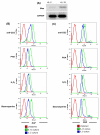T cells expanded in presence of IL-15 exhibit increased antioxidant capacity and innate effector molecules
- PMID: 21602054
- PMCID: PMC3595556
- DOI: 10.1016/j.cyto.2011.04.014
T cells expanded in presence of IL-15 exhibit increased antioxidant capacity and innate effector molecules
Abstract
Persistence of effector cytotoxic T lymphocytes (CTLs) during an immunological response is critical for successfully controlling a viral infection or tumor growth. Various cytokines are known to play an important part in regulating the immune response. The IL-2 family of cytokines that includes IL-2 and IL-15 are known to function as growth and survival factors for antigen-experienced T cells. IL-2 and IL-15 possess similar properties, including the ability to induce T cell proliferation. Whereas long-term IL-2 exposure has been shown to promote apoptosis and limit CD8(+) memory T cell survival and proliferation, it is widely believed that IL-15 can inhibit apoptosis and helps maintain a memory CD8(+) T-cell population. However, mechanisms for superior outcomes for IL-15 as compared to IL-2 are still under investigation. Our data shows that human T cells cultured in the presence of IL-15 exhibit increased expression of anti-oxidant molecules glutathione reductase (GSR), thioredoxin reductase 1 (TXNDR1), peroxiredoxin (PRDX) and superoxide dismutase (SOD). An increased expression of cell-surface thiols, intracellular glutathione, and thioredoxins was also noted in IL-15 cultured T cells. Additionally, IL-15 cultured T cells showed an increase in cytolytic effector molecules. Apart from increased level of Granzyme A and Granzyme B, IL-15 cultured T cells exhibited increased accumulation of reactive oxygen (ROS) and reactive nitrogen species (RNS) as compared to IL-2 cultured T cells. Overall, this study suggests that T cells cultured in IL-15 show increased persistence not only due to levels of anti-apoptotic proteins, but also due to increased anti-oxidant levels, which is complimented by increased cytolytic effector functions.
Copyright © 2011 Elsevier Ltd. All rights reserved.
Figures





References
Publication types
MeSH terms
Substances
Grants and funding
LinkOut - more resources
Full Text Sources
Other Literature Sources
Medical
Research Materials

